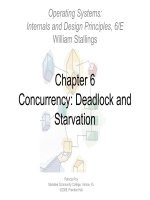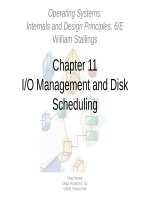Lecture Operating systems Internals and design principles (6 E) Chapter 8 William Stallings
Bạn đang xem bản rút gọn của tài liệu. Xem và tải ngay bản đầy đủ của tài liệu tại đây (831.02 KB, 110 trang )
Operating Systems:
Internals and Design Principles, 6/E
William Stallings
Chapter 8
Virtual Memory
Dave Bremer
Otago Polytechnic, N.Z.
©2008, Prentice Hall
Roadmap
•
•
•
•
•
Hardware and Control Structures
Operating System Software
UNIX and Solaris Memory Management
Linux Memory Management
Windows Memory Management
Terminology
Key points in
Memory Management
1) Memory references are logical addresses
dynamically translated into physical
addresses at run time
– A process may be swapped in and out of main
memory occupying different regions at
different times during execution
2) A process may be broken up into pieces
that do not need to located contiguously in
main memory
Breakthrough in
Memory Management
• If both of those two characteristics are
present,
– then it is not necessary that all of the pages or
all of the segments of a process be in main
memory during execution.
• If the next instruction, and the next data
location are in memory then execution can
proceed
– at least for a time
Execution of a Process
• Operating system brings into main
memory a few pieces of the program
• Resident set - portion of process that is in
main memory
• An interrupt is generated when an address
is needed that is not in main memory
• Operating system places the process in a
blocking state
Execution of a Process
• Piece of process that contains the logical
address is brought into main memory
– Operating system issues a disk I/O Read
request
– Another process is dispatched to run while the
disk I/O takes place
– An interrupt is issued when disk I/O complete
which causes the operating system to place
the affected process in the Ready state
Implications of
this new strategy
• More processes may be maintained in
main memory
– Only load in some of the pieces of each
process
– With so many processes in main memory, it is
very likely a process will be in the Ready state
at any particular time
• A process may be larger than all of main
memory
Real and
Virtual Memory
• Real memory
– Main memory, the actual RAM
• Virtual memory
– Memory on disk
– Allows for effective multiprogramming and
relieves the user of tight constraints of main
memory
Thrashing
• A state in which the system spends most
of its time swapping pieces rather than
executing instructions.
• To avoid this, the operating system tries to
guess which pieces are least likely to be used in
the near future.
• The guess is based on recent history
Principle of Locality
• Program and data references within a
process tend to cluster
• Only a few pieces of a process will be
needed over a short period of time
• Therefore it is possible to make intelligent
guesses about which pieces will be
needed in the future
• This suggests that virtual memory may
work efficiently
A Processes Performance
in VM Environment
• Note that during
the lifetime of the
process,
references are
confined to a
subset of pages.
Support Needed for
Virtual Memory
• Hardware must support paging and
segmentation
• Operating system must be able to manage
the movement of pages and/or segments
between secondary memory and main
memory
Paging
• Each process has its own page table
• Each page table entry contains the frame
number of the corresponding page in main
memory
• Two extra bits are needed to indicate:
– whether the page is in main memory or not
– Whether the contents of the page has been
altered since it was last loaded
(see next slide)
Paging Table
Address Translation
Page Tables
• Page tables are also stored in virtual
memory
• When a process is running, part of its
page table is in main memory
Two-Level
Hierarchical Page Table
Address Translation for
Hierarchical page table
Page tables
grow proportionally
• A drawback of the type of page tables just
discussed is that their size is proportional
to that of the virtual address space.
• An alternative is Inverted Page Tables
Inverted Page Table
• Used on PowerPC, UltraSPARC, and IA64 architecture
• Page number portion of a virtual address
is mapped into a hash value
• Hash value points to inverted page table
• Fixed proportion of real memory is
required for the tables regardless of the
number of processes
Inverted Page Table
Each entry in the page table includes:
• Page number
• Process identifier
– The process that owns this page.
• Control bits
– includes flags, such as valid, referenced, etc
• Chain pointer
– the index value of the next entry in the chain.
Inverted Page Table
Translation Lookaside
Buffer
• Each virtual memory reference can cause
two physical memory accesses
– One to fetch the page table
– One to fetch the data
• To overcome this problem a high-speed
cache is set up for page table entries
– Called a Translation Lookaside Buffer (TLB)
– Contains page table entries that have been
most recently used
TLB Operation
• Given a virtual address,
– processor examines the TLB
• If page table entry is present (TLB hit),
– the frame number is retrieved and the real
address is formed
• If page table entry is not found in the TLB
(TLB miss),
– the page number is used to index the process
page table









